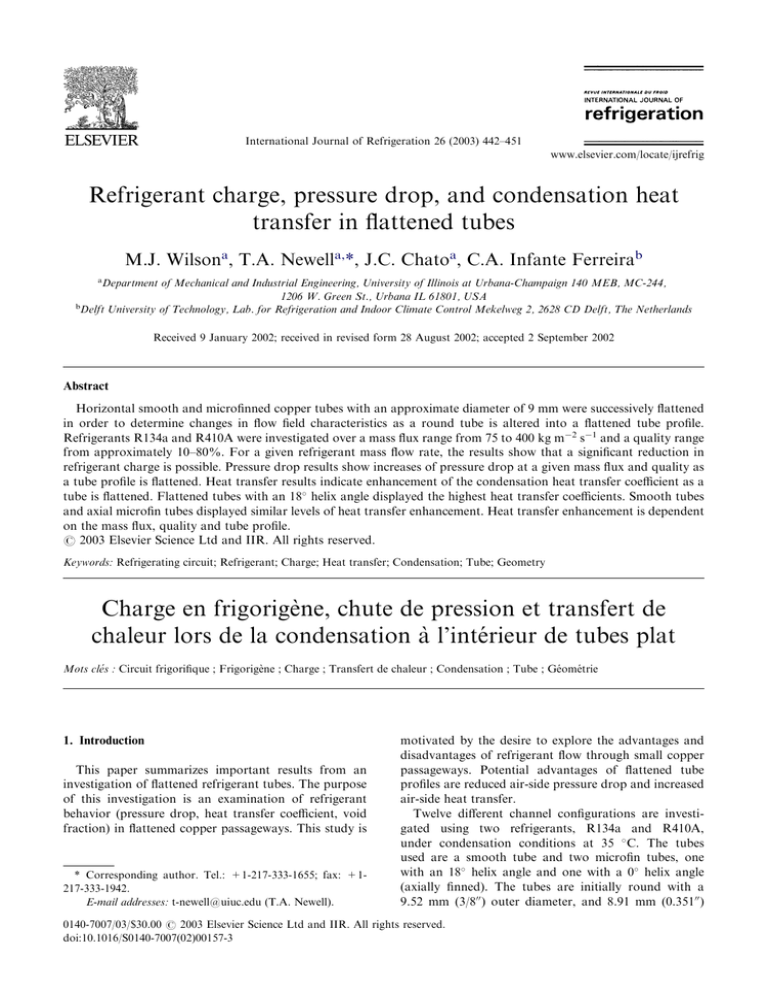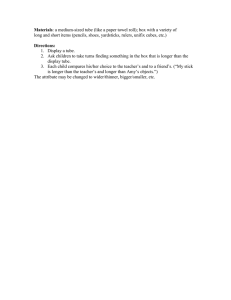
International Journal of Refrigeration 26 (2003) 442–451
www.elsevier.com/locate/ijrefrig
Refrigerant charge, pressure drop, and condensation heat
transfer in flattened tubes
M.J. Wilsona, T.A. Newella,*, J.C. Chatoa, C.A. Infante Ferreirab
a
Department of Mechanical and Industrial Engineering, University of Illinois at Urbana-Champaign 140 MEB, MC-244,
1206 W. Green St., Urbana IL 61801, USA
b
Delft University of Technology, Lab. for Refrigeration and Indoor Climate Control Mekelweg 2, 2628 CD Delft, The Netherlands
Received 9 January 2002; received in revised form 28 August 2002; accepted 2 September 2002
Abstract
Horizontal smooth and microfinned copper tubes with an approximate diameter of 9 mm were successively flattened
in order to determine changes in flow field characteristics as a round tube is altered into a flattened tube profile.
Refrigerants R134a and R410A were investigated over a mass flux range from 75 to 400 kg m2 s1 and a quality range
from approximately 10–80%. For a given refrigerant mass flow rate, the results show that a significant reduction in
refrigerant charge is possible. Pressure drop results show increases of pressure drop at a given mass flux and quality as
a tube profile is flattened. Heat transfer results indicate enhancement of the condensation heat transfer coefficient as a
tube is flattened. Flattened tubes with an 18 helix angle displayed the highest heat transfer coefficients. Smooth tubes
and axial microfin tubes displayed similar levels of heat transfer enhancement. Heat transfer enhancement is dependent
on the mass flux, quality and tube profile.
# 2003 Elsevier Science Ltd and IIR. All rights reserved.
Keywords: Refrigerating circuit; Refrigerant; Charge; Heat transfer; Condensation; Tube; Geometry
Charge en frigorigène, chute de pression et transfert de
chaleur lors de la condensation à l’intérieur de tubes plat
Mots cle´s : Circuit frigorifique ; Frigorigène ; Charge ; Transfert de chaleur ; Condensation ; Tube ; Géométrie
1. Introduction
This paper summarizes important results from an
investigation of flattened refrigerant tubes. The purpose
of this investigation is an examination of refrigerant
behavior (pressure drop, heat transfer coefficient, void
fraction) in flattened copper passageways. This study is
* Corresponding author. Tel.: +1-217-333-1655; fax: +1217-333-1942.
E-mail addresses: t-newell@uiuc.edu (T.A. Newell).
motivated by the desire to explore the advantages and
disadvantages of refrigerant flow through small copper
passageways. Potential advantages of flattened tube
profiles are reduced air-side pressure drop and increased
air-side heat transfer.
Twelve different channel configurations are investigated using two refrigerants, R134a and R410A,
under condensation conditions at 35 C. The tubes
used are a smooth tube and two microfin tubes, one
with an 18 helix angle and one with a 0 helix angle
(axially finned). The tubes are initially round with a
9.52 mm (3/800 ) outer diameter, and 8.91 mm (0.35100 )
0140-7007/03/$30.00 # 2003 Elsevier Science Ltd and IIR. All rights reserved.
doi:10.1016/S0140-7007(02)00157-3
M.J. Wilson et al. / International Journal of Refrigeration 26 (2003) 442–451
443
2. Experimental facility and procedures
Nomenclature
As
D
Dh
e
EF
f
Fr
Ft
g
G
h
hfin
P
Re
Xtt
x
surface area, m2
diameter, m
hydraulic diameter, m
tube roughness, m
enhancement factor
friction factor
Froude number
Froude rate parameter
gravity, 9.81 m s2
mass flux, kg m2 s1
heat transfer coefficient, Wm2 K1
fin height, m
perimeter, m
Reynolds number
Lockhart Martinelli parameter
quality
void fraction
helix angle
two phase multiplier
density, kg m3
viscosity, kg m1 s1
Subscripts
v
vapor
l
liquid
inner base diameter. The tubes are successively flattened into an oblong shape with inside heights of 5.74
mm, 4.15 mm, 2.57 mm, and 0.974 mm (0.22600 ,
0.16300 , 0.10100 , 0.038300 ) as shown in Figs. 1 and 2.
The corresponding hydraulic diameters are 7.79 mm,
6.37 mm, 4.40 mm, and 1.84 mm. The microfin tubes
contain 60 fins around the tube perimeter with
approximate fin height of 0.2 mm. The microfins
increase the internal surface area by 60% over the
smooth tube.
Fig. 3 is a schematic of the experimental apparatus
used in this study. A magnetically coupled, variable
speed pump is used to circulate liquid refrigerant. The
pump requires no lubricant, leaving the refrigerant
uncontaminated. The mass flow rate of the refrigerant is
measured using a Coriolis-type mass flow meter. The
refrigerant passes through the pre-heater that consists of
a series of electric heater strips. The pre-heater is used to
condition the flow from sub-cooled liquid to the desired
two-phase quality. Two-phase refrigerant then enters
the test section. After the test section, the refrigerant is
cooled using a water-cooled condenser. The refrigerant
then enters a receiver tank to separate the liquid from
any remaining vapor.
The test sections are horizontally mounted 1.22 m
(4800 ) long copper tubes. Pressure taps are soldered at
the inlet and outlet, and are attached to a differential
pressure transducer and an absolute pressure transducer. A void fraction tap is also soldered onto the test
section to allow for the extraction of refrigerant from
the test section. At the test section inlet and outlet are
two ball valves that can be simultaneously closed for
void fraction sampling.
To flatten the test section tube, the 9.525 mm (3/800 )
diameter round tube is placed between two 6.35 mm (1/
400 ) thick by 25.4 mm (100 ) wide by 1.2 m long copper bars.
A spacer, with heights of 6.35 mm, 4.76 mm, 3.18 mm, or
1.59 mm (1/400 , 3/1600 , 1/800 , or 1/1600 ) is then placed
between the two copper bars. The two copper bars are
then tightened to together using a series of bolts spaced
approximately 25.4 mm apart along the test section
length. The outside tube height of the test section is
determined by the spacer. Copper coolant tubes are soldered to the outside surface of the copper bars. Water is
passed through the coolant tubes on top and on bottom
of the copper bars in a counter flow configuration. The
water is able to remove up to 400 W from the refrigerant.
Four wall-mounted thermocouples are placed every
0.3 m (9.600 ) at four stations along the test section tube
length to measure the tube wall temperature. The four
Fig. 1. Photograph of flattened tube cross sections.
444
M.J. Wilson et al. / International Journal of Refrigeration 26 (2003) 442–451
Fig. 2. Dimensions of flattened tube cross-sections.
Fig. 3. Schematic of refrigerant test loop.
thermocouples at each station are mounted on the top,
bottom, and opposing sides of the tube.
Experiments were performed using both R134a and
R410A at an inlet temperature of 35 C. The mass flux
was generally varied from 75 kg m2 s1 to 400 kg m2
s1. The inlet quality was varied from 10% up to 80%.
During heat transfer tests, the inlet and outlet quality
variations of the test section were between 0.05 to 0.5.
The average of the inlet and outlet quality has been used
to define the quality in the figures presented. The greatest quality changes occurred in the flattest test sections
where refrigerant mass flow rates were smallest.
The test section tubes had a nominal outside diameter
of 9.53 mm (3/800 ) with a wall thickness of 0.3 mm
(0.01200 ). The fin height on the microfin tubes was 0.2
mm (0.00800 ) with a total of 60 fins. The helical and axial
finned tubes had identical cross-section geometry. The
tubes were successively flattened from an initial internal
diameter of 8.91 mm (0.35100 ) to heights of 5.74 mm,
4.15 mm, 2.57 mm, and 0.974 mm (0.22600 , 0.16300 ,
0.10100 , 0.038300 ). In the microfin tubes, this is the distance from the base of the fin to the base of fin on the
other side of the tube.
The refrigerants tested in this experiment represent a
mid-pressure refrigerant (R134a) and a high-pressure
refrigerant (R410A). It is believed that refrigerants with
vapor pressures between these limits (e.g., R22 and
R404A) and similar liquid thermal conductivity and
viscosity will behave in a manner somewhere between
the R134a and R410A results.
The void fraction measurement technique is one that
has been commonly used by others [1]. First, the test
section inlet condition must be set to the desired temperature, quality, and mass flow rate. The valves on
both sides of the test section are closed simultaneously
and a by-pass line of the refrigerant flow circuit is
opened. A valve on the void fraction tap connecting the
test section to a receiver tank is opened, allowing
refrigerant to flow out of the test section and into the
tank. The tank is cooled in an ice bath. After the mass
has migrated to the receiver tank, the temperature and
pressure of the test section are recorded and the void
fraction tap valve is closed.
The amount of vapor mass left in the test section is
calculated and the mass collected in the receiving tank is
weighed. The specific volume of the test section refrigerant is determined by dividing the test section volume
by the refrigerant mass. All thermodynamic properties
are evaluated at the test section inlet condition of 35 C.
The most common source of error in the void fraction
experiment is refrigerant leaks. Refrigerant can leak
from loose fittings and improperly soldered joints,
resulting in lower than actual amounts of mass in the
receiving tank. Also, leaks across the shutoff valves can
add refrigerant mass to the receiving tank. This method
gives consistent mass readings to within 0.5 gram
(usually less than 5% of test section mass).
Heat transfer coefficients are determined by measuring the temperature difference between the tube wall and
refrigerant with a measured heat transfer. The refrigerant temperature is measured at the inlet and outlet of
the test section. The ‘‘local’’ refrigerant temperature at
each thermocouple station is linearly interpolated from
the inlet and outlet refrigerant temperatures. The heat
transfer is determined from the water circulated through
the cooling circuits bonded to the copper bars. The
water mass flow rate in the cooling circuit is measured
by the ‘‘bucket-stopwatch’’ method.
445
M.J. Wilson et al. / International Journal of Refrigeration 26 (2003) 442–451
Instrumentation includes thermocouples, differential
and absolute pressure transducers, mass flow meters,
and watt-hour transducers. Type T thermocouples were
used to measure temperature. The uncertainty of these
thermocouples was measured to be 0.25 C. The
uncertainty of the absolute pressure transducers was
calculated to be 35 kPa (5 psi). The range of the differential pressure transducer is 0–35 kPa (0–5 psi), with
an accuracy of 0.4 kPa. Two watt-hour transducers
were used to measure the pre-heater inlet power. The
accuracy of these transducers were individually calculated by single-phase liquid flow energy balances to be
within 3%. The refrigerant mass flow meter was found to
be accurate to within 3% by comparison with a bucketstopwatch calibration. An error analysis [2] indicates that
quality can be calculated to within 10% and the mass flux
to within 5 kg m2 s1. The void fraction can be measured accurately to within 8%, pressure drop to within 0.4
kPa, and heat transfer coefficient to within 20%.
3. Void fraction results
Two-phase refrigerant void fraction data was collected for each of flattened tube profiles for refrigerants
R134a and R410A. The quality was varied from 10% to
80% and the mass flux ranged from 75 to 400 kg m2
s1. The data was compared to a correlation given by
Wilson et al. [2] in which the void fraction is dependent
on the Lockhart Martinelli parameter (Xtt) and a modified Froude Number (Ft).
1 x 0:9 v 0:5 l 0:1
Xtt ¼
ð1Þ
x
l
v
12
x3 G 2
ð2Þ
Ft ¼ 2
v gDð1 xÞ
¼ ð1 þ a=Ft þ bXtt Þn
Fig. 4. Relative changes in refrigerant charge for flattened
tubes with refrigerants R134a and R410A.
than 2.5 mm, or if (Xtt+1/Ft) is greater than or less
than 2].
The main effect of flattening a tube at a constant mass
flow rate is the increased vapor velocity. The bulk of a
tube’s cross section at qualities greater than 0.2 is vapor.
When a tube’s cross section is reduced in half, the vapor
velocity is essentially doubled, which is a quadrupling of
the vapor’s kinetic energy. This increase in vapor kinetic
energy results in a higher shearing of the liquid layer, thinning the liquid phase, which reduces the mass in the tube.
Charge requirements of a heat exchanger can be
determined by numerical integration of the void fraction
relation over a quality range of interest. Fig. 4 displays
the effect of flattening the tube on refrigerant charge
ratio. The ratio of charge in a flattened tube to charge in
a round tube has little dependence on mass flux or
refrigerant type. The total charge, however, will depend
on both mass flux and refrigerant. The ratio is highly
dependent on tube height.
ð3Þ
4. Pressure drop results
New constants (a,b,n) were used to update this
correlation for flattened tubes. These constants appear
in Tables 1 and 2. Different constants are used for different flow regimes [if the tube height is greater or less
The experimental pressure drop for the test sections
was compared against pressure drop correlations found
in the published literature [2]. For flattened tubes, the
Table 1
Void fraction correlation constants for tube heights greater
than 2.5 mm
Table 2
Void fraction correlation constants for tube heights of 0.974
mm
Tube
Xtt+1/Ft
a
b
n
Tube
Xtt+1/Ft
a
b
n
Smooth
<2.00
>2.00
<2.00
>2.00
<2.00
>2.00
1.84
0.5
5.80
1.50
1.38
2.26
3.11
1.2
8.60
2.70
3.30
2.50
0.21
0.35
0.16
0.31
0.26
0.26
Smooth
<2.00
>2.00
<2.00
>2.00
<2.00
>2.00
1.84
0.5
5.80
1.50
1.38
2.26
3.11
1.2
8.60
2.70
3.30
2.50
0.21
0.35
0.16
0.31
0.26
0.26
18 Helix
0 Helix
18 Helix
0 Helix
446
M.J. Wilson et al. / International Journal of Refrigeration 26 (2003) 442–451
diameter length scale was chosen to be the hydraulic diameter of the smooth tube (Dh=4A/P). Two correlations
presented in this work for illustrative purposes are the
models by Jung and Radermacher [3] and Souza et al. [4].
These models are both ‘‘two-phase multiplier’’ type models
that are functions of the Lockhart Martinelli parameter.
The Jung and Radermacher [3] model uses the ‘‘liquid
only’’ formulation. The liquid only formulation treats
all refrigerant mass flow as if it is in the liquid phase.
That is, the single phase pressure gradient is determined
from a suitable single phase friction factor expression
with all refrigerant mass flow considered as liquid. The
two-phase multiplier is given by the relation:
2lo ¼ 12:82X1:47
ð1 xÞ1:8
tt
ð5Þ
And the two-phase pressure gradient is determined
from:
dP
dP
Þf ¼ 2lo
ð6Þ
dz
dz lo
Fig. 5. Comparison of pressure drop predictions of the Souza
and Jung–Radermacher correlations with experimental data for
a smooth tube flattened to 0.974 mm height.
The Souza et al. [4] correlation is based on the
‘‘liquid’’ two-phase multiplier. In this case, only that
liquid mass for a given quality is used is used for determining the single phase pressure gradient. This model
uses a simple Froude number expression to differentiate
between stratified and annular flow regions as seen in
the relations below.
2
2l ¼ 1:376 þ c1 Xc
tt
ð7Þ
c1 ¼ 4:172 þ 5:48Fr1 1:564Fr21 Fr1 < 0:7
ð8Þ
c1 ¼ 7:242Fr1 > 0:7
ð9Þ
c2 ¼ 1:773 0:169Frl Fr1 < 0:7
ð10Þ
c2 ¼ 1:655Fr1 > 0:7
ð11Þ
dP
Þ ¼ 2l
dz f
dP
dz l
ð12Þ
where the liquid Froude number is defined as: Frl ¼
G
pffiffiffiffiffiffiffi To account for the effects of microfins, the
l gD
Cavallini et al. [5] roughness ratio is used in conjunction
with the Colebrook [6] friction factor relation.
e
hfin
1
¼ 0:18
D
Dh 0:1 þ cos
1
e=D
2:51
þ
¼ 2:0log10
f 0:5
3:7 Ref 0:5
ð13Þ
Fig. 6. Comparison of pressure drop predictions of the Souza
and Jung–Radermacher correlations with experimental data for
an 18 helix tube flattened to 0.974 mm height.
Radermacher [3] and Souza et al. [4] predict the pressure
drop to within 40%. The correlations used for comparison exhibit the same trends no matter the tube height or
internal geometry with Jung and Radermacher [3] giving
somewhat higher pressure drop predictions than Souza
et al. [4]. The data suggests that standard correlations
can be used by determining the smooth tube hydraulic
diameter and an equivalent microfin roughness factor.
ð14Þ
5. Heat transfer coefficients
Figs. 5–7 present pressure drop data for smooth, 18
helix, and 0 helix tubes flattened to 0.974 mm high. The
pressure drop correlations developed by Jung and
The third phase of this study examined two-phase
refrigerant heat transfer coefficients in the flattened test
M.J. Wilson et al. / International Journal of Refrigeration 26 (2003) 442–451
Fig. 7. Comparison of pressure drop predictions of the Souza
and Jung–Radermacher correlations with experimental data for
a 0 (axially grooved) helix tube flattened to 0.974 mm height.
sections. As previously described, the local heat transfer
coefficient was determined from the water cooling rate
and by measuring the local wall and refrigerant temperatures. Inlet and outlet qualities varied between 0.05
and 0.5 with the flattest sections at low mass fluxes
resulting in the largest test section quality changes. In
each case, the cooling rate and the test section quality was
adjusted such that the refrigerant inlet and outlet were in
saturation. The average of the inlet and outlet quality is
used as the ‘‘local’’ quality in the figures presented.
The heat transfer results display a number of complex
trends. Although many investigators have studied
refrigerant condensation in round tubes, our understanding of the basic fluid mechanic processes are quite
limited [7]. In this study, it is hoped that the successive
flattening of an initially round tube minimizes errors
that may occur between different test section tubes of
varying cross section. That is, the current method was
selected in order to have minimal disturbance of wall
thermocouples, cooling water flow, test section joints,
etc., such that relative changes of heat transfer can be
observed as a round tube’s cross section profile is continuously altered.
The measured heat transfer coefficients are compared
to the round smooth tube heat transfer coefficients at
the same mass flux by defining an ‘‘enhancement factor’’.
EF ¼
ðhAs Þ
ðhAs ÞrsG
ð15Þ
The denominator in Eq. (15) represents the heat
transfer of a smooth round tube at the same mass flux as
the flattened tube. In order to have a consistent basis for
predicting the condensation heat transfer of a smooth
round tube, several smooth tube heat transfer models
447
Fig. 8. Condensation heat transfer coefficient data for a 8.91
mm diameter smooth, round tube. Saturation temperature is
35 C and mass flux (G) is in kg m2 s1.
were compared to the experimental smooth tube condensation heat transfer results. Varying levels of agreement was found among many popular models [2]. The
smooth tube experimental results tended to be consistently lower than the heat transfer coefficients predicted by the Dobson and Chato [8] model by
approximately 20–30%. A simple multiplier constant
was used to adjust the Dobson and Chato [8] prediction
model in order to develop a reference for the enhancement factor calculations, resulting in a smooth round
tube enhancement factor of approximately unity for the
experimental results collected in this study.
Fig. 8 is a plot of the condensation heat transfer
coefficient results for the smooth round tube at two
mass fluxes for refrigerants R134a and R410A. Both
increasing mass flux and quality tend to increase the
heat transfer coefficients as expected. These refrigerants,
as well as other halogenated refrigerants in the midpressure to high pressure range tend to have similar
levels of heat transfer coefficients. R410A has a relatively high liquid thermal conductivity that somewhat
compensates for its lower vapor velocity in comparison
to R134a. Fig. 9 presents condensation heat transfer
coefficient data for the smooth tube flattened to an
internal height of 2.57 mm. At mass fluxes equivalent to
those in Fig. 8, elevated levels of heat transfer are
observed.
The reasons for elevated heat transfer in the flattened
tube are unknown, but some speculation concerning the
enhancement of heat transfer can be made. First, the
lowered height of the tube reduces the energy needed to
wet the upper tube surface, possibly causing transition
from stratified flow to an annular flow configuration
earlier than a round tube. Annular flow tends to have
higher rates of heat transfer because the film around the
448
M.J. Wilson et al. / International Journal of Refrigeration 26 (2003) 442–451
Fig. 9. Condensation heat transfer coefficient data for a
smooth tube flattened to an internal height of 2.57 mm.
Saturation temperature is 35 C and mass flux (G) is in kg
m2 s1.
Fig. 10. Condensation heat transfer coefficient data for a 18
helix angle microfin tube flattened to an internal height of 4.15
mm. Saturation temperature is 35 C and mass flux (G) is in kg
m2 s1.
tube increases the turbulent interaction between the
vapor and liquid phases through the ‘‘roughness’’ of the
liquid film. Second, the flattened tube may alter the flow
field in a manner that increases the heat transfer without
changing the flow field configuration. That is, the flow
field may be unaltered from a stratified or annular flow
configuration, but the flow field within that configuration may be affected. For example, some annular flows
have ‘‘disturbance wave’’ or ‘‘ring wave’’ structures
while others do not. A third possibility is the formation
of a different flow field configuration from that commonly observed in round tubes. Shedd [9] observed
interesting liquid wall film thickness variations in noncircular (square, diamond, and triangular cross sections)
tubes, apparently caused by the secondary flow field and
streamwise flow field variations. In a flattened tube,
such flow field variations may also develop. The noncircular shape may also allow the liquid phase to segregate by migrating to one or both of the side regions,
with vapor primarily flowing through the center channel
region of the tube.
Figs. 10 and 11 present sample condensation heat
transfer data for the microfin tubes. Fig. 10 presents
results for the 18 helix tube with an internal flattening
height of 4.15 mm. A significant jump in heat transfer is
observed as the mass flux is increased from a mass flux
of 75 kg m2 s1 to the higher mass flux levels. A less
prominent change of heat transfer with mass flux
increases is observed in the axial tube data for an internal flattening height of 2.57 mm shown in Fig. 11. A
study of microfin tube condensation for round 18 degree
and axially finned tubes is given by Graham et al. [10].
The local condensation effects of a round, axial finned
tube are especially interesting because of localized
regions of relatively high enhancement. These effects
further complicate the possible nature of the effects displayed by a flattened tube.
Enhancement factors, in combination with heat
transfer coefficient information help describe the effects
of tube flattening. As previously mentioned, a smooth,
round tube is used as the reference case for the flattened
tube results. Fig. 12 presents the effect of internal tube
flattening height for the smooth tube for two mass fluxes
for refrigerants R134a and R410A. Results for Fig. 12
were selected from experiments in which the average
quality is 0.3 ( 0.05). A trend line is sketched through
the data. A peak enhancement in this mass flux range
Fig. 11. Condensation heat transfer coefficient data for an axial
microfin tube flattened to an internal height of 2.57 mm. Saturation temperature is 35 C and mass flux (G) is in kg m2 s1.
M.J. Wilson et al. / International Journal of Refrigeration 26 (2003) 442–451
449
Fig. 12. Enhancement factor versus tube height for a flattened
smooth tube at an approximate quality of 0.3. The mass flux
(G) is in kg m2 s1.
Fig. 14. Heat transfer enhancement factors for R134a in an 18
helix angle tube flattened to 2.57mm over a range of quality
and mass flux (mass flux, G, is kg m2 s1).
Fig. 13. Heat transfer enhancement factors for R134a in a
smooth tube flattened to 2.57 mm over a range of quality and
mass flux (mass flux, G, is kg m2 s1).
Fig. 15. Heat transfer enhancement factors for R134a in a 0
helix angle tube flattened to 2.57 mm over a range of quality
and mass flux (mass flux, G, is kg m2 s1).
for both refrigerants is observed at approximately 3 mm
tube height.
Figs. 13–15 show enhancement factor trends for the
smooth tube, 18 degree microfin tube, and axial microfin tube with an internal height of 2.57 mm (near the
optimal flattening height observed in Fig. 12 for the
smooth tube). For clarity, only results for R134a are
shown. Similar effects are observed for R410A. Third
order polynomial trendlines have been sketched over
each set of mass flux data on the plots in order to help
identify changes of heat transfer as the mass flux is varied. The 18 helix microfin tube display significantly
higher levels of enhancement over both the smooth and
axial microfin tubes. One thought regarding the 18
tube’s performance is that as its upper and lower walls
are brought closer together, the alternating directions of
the microfins cause a favorable distribution of the liquid
flow, resulting in an overall thinner average liquid film
thickness. An interesting trend observed in each of these
figures is the relatively low enhancement factor at the
lowest mass flux level, followed by a significant increase
of enhancement factor with mass flux. The increase of
enhancement factor is also seen to be dependent on quality. Beyond a certain mass flux, however, the enhancement
factor in the microfin tubes drops to a fairly steady level.
The smooth tube builds to its highest level of enhancement
factor at the highest mass flux shown in Fig. 13. It is
unknown if the enhancement factor for the smooth tube
would begin decreasing if the mass flux were increased
beyond the level shown in Fig. 13.
450
M.J. Wilson et al. / International Journal of Refrigeration 26 (2003) 442–451
with microfin tubes. A more accurate model for
exploiting the possible benefits of a flattened tube condenser would also consider the variations of the tube
flattening on the air side pressure drop and heat transfer.
7. Conclusions
The purpose of this study was to explore the refrigerant side flow characteristics inside of flattened tubes.
Some of the findings of flat tubes are:
Fig. 16. System simulation prediction results for heat transfer,
pressure drop, and charge ratios in a condensing tube circuit as
a function of tube height.
6. Combined prediction of charge, pressure drop and
heat transfer
The experimental results from the preceding sections
can be used to model tubes in a heat exchanger. As an
example, a smooth condenser tube with a thermal load
capacity of 1750 Watts is modeled. R134a is chosen to
be the refrigerant with an inlet temperature of 35 C.
The heat exchanger tube is divided into 100 sections,
with each section having a quality change of 1%. Using
the average quality in each section, the refrigerant side
heat transfer coefficient, pressure drop, and void fraction is calculated. Using the refrigerant side heat transfer coefficient in conjunction with an assumed air-side
heat transfer value of 28.0 Wm1 K1 (per unit length
of the heat exchanger tube), the length of each section
can be determined. Next, the pressure drop and refrigerant mass in the section can be calculated. The properties of each section are then added to determine the
length, refrigerant mass, and pressure drop in the heat
exchanger circuit.
The results of the smooth tube simulation appear in
Fig. 16. In this figure, the changes in pressure drop,
refrigerant mass, and tube length (heat transfer area)
are compared. These changes are represented as a ratio
of the flattened tube heat exchanger characteristics, to
the round tube heat exchanger characteristics. As the
tube is flattened, the total length of tube required
decreases, the total refrigerant mass decays exponentially, and the pressure drop increases exponentially. At
a height of 5 mm the pressure drop has increased by
70%, while the total tube length has decreased by 10%,
and the amount of refrigerant required has decreased by
40%. The decrease of the length by only 10% is due to
the air side being the dominate resistance to heat transfer.
The simulation shows similar results for comparisons
Significant reduction in refrigerant mass occur
as a tube is flattened
Pressure drop results scale with hydraulic diameter
Microfin pressure drop effects can be modeled
with equivalent roughness factors
Heat transfer enhancements are observed as
tube profiles are flattened
18 helix angle microfin tubes have significantly
higher heat transfer than either smooth or axial
microfin tubes
The downside of flattening a tube is the increased
pressure drop penalty. One possible alternative is to
flatten a large tube to increase the hydraulic diameter or
to add more parallel circuits. These modifications,
however, require more detailed economic considerations
by heat exchanger and system manufacturers.
Acknowledgements
The authors appreciate the support of the Copper
Development Association and its member companies
for providing financial support and guidance.
References
[1] Sacks PS. Measured characteristics of adiabatic and condensing single-component two-phase flow of refrigerant in
a 0.377 in. diameter horizontal tube. ASME Winter
Annual Meeting, 75-WA/HT-24, 1975.
[2] Wilson MJ, Newell TA Chato JC. A study of two-phase
refrigerant behavior in flattened tubes. ACRC report CR35. Air Conditioning and Refrigeration Center, University
of Illinois at Urbana-Champaign, 2001.
[3] Jung DS, Radermacher R. Prediction of pressure drop
during horizontal annular flow boiling of pure and
mixed refrigerants. Int J Heat Transfer 1989;32(12):
2435–46.
[4] Souza AL, Chato JC, Wattelet JP, Christoffersen BR.
Pressure drop during two-phase flow of pure refrigerants
and refrigerant-oil mixtures in horizontal smooth tubes.
M.J. Wilson et al. / International Journal of Refrigeration 26 (2003) 442–451
Heat Transfer with Alternate Refrigerants, ASME HTD
1993;243:35–41.
[5] Cavallini A, Del Col D, Doretti L, Longo GA, Rossetto
L. Heat transfer and pressure drop during condensation of
refrigerants inside horizontal enhanced tubes. Int J
Refrigeration 2000;23:4–25.
[6] Colebrook CF. Turbulent flow in pipes, with particular
reference to the transition region between the smooth and
rough pipe laws. J of the Institution of Civil Engineers,
London 1938–1939;11:133–56.
[7] Newell TA, Shah R. An assessment of refrigerant heat
451
transfer, pressure drop, and void fraction effects in microfin tubes. Int J HVAC&R Research 2000;7(2):125–53.
[8] Dobson MK, Chato JC. Condensation in smooth horizontal tubes. J Heat Transfer 1998;120:193–213.
[9] Shedd TA. Characteristics of the liquid film in horizontal
two-phase flow. PhD thesis, University of Illinois at
Urbana-Champaign, 2001.
[10] Graham D, Chato JC, Newell TA. Heat transfer and
pressure drop during condensation of refrigerant 134a in
an axially grooved tube. Int J Heat and Mass Transfer
1999;42:1935–44.





